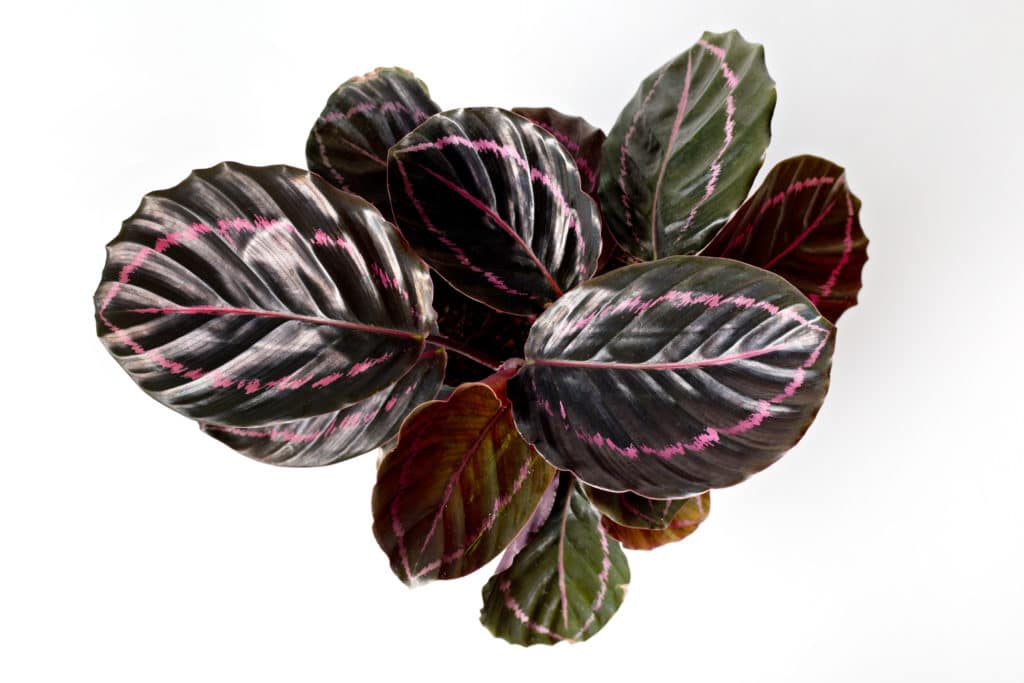
Calathea Dottie (Calathea roseopicta) Breakdown
Light: Medium indirect light
Humidity: Medium to high
Soil: Well draining
Watering: Frequent
Calathea Dottie Care
Calathea Dottie (Calathea roseopicta) is a member of the Calatheas that has beautiful dark and pink foliage, similar to the gothic cousin of the family. Like many other varieties of Calathea plant, she may be fussy and hard to manage, but she is just as beautiful for the same reason.
If you follow our care instructions for Calathea Dottie, you should have a good understanding of how it should be cared for; if you do have issues with this plant, however, you aren’t alone.
Light
It is critical that your Calathea Dottie does not receive direct sunlight. If this prayer plant is kept in direct sunshine, the leaves can be burned and the plant damaged. It begins with color loss but it goes much deeper than that.
It can do significant damage going even deeper than color fading. Instead, pick a location for it where it receives medium light and is protected from the sun. As a result, a north or east-facing room may be ideal.
Find a nice location with plenty of bright indirect light for your Calathea Dottie. Keep them away from concentrated direct sunlight since this could burn the leaves.
Watering
Calatheas require a lot of attention, but they also appreciate plenty of water once in a while. They should be kept damp yet not submerged. You may most likely water your Calathea Dottie once a week, but it’s preferable to check each plant separately.
When the top two inches of soil begin to dry out, it’s time to give your plant a drink. You could also discover that tap water is too strong for this plant and you might wish to use filtered water instead.
Calathea Dottie plants don’t like their potting mix to be too dry or soggy. To retain moisture in the soil, water them only slightly but frequently. There is no danger of root rot or drought as a result of this method.
Soil
Look for a well-draining soil if possible. Because you’ll be watering this plant frequently, it’s critical that the soil doesn’t stay soggy, so use a potting mix with adequate drainage holes and perlite in the mix. This plant will also appreciate the addition of some extra pebbles or small stones in the bottom of the pot to help with drainage.
Humidity
Calathea Dottie thrives in a humid environment. If the air is too dry, the leaves will begin to curdle, and once this damage has occurred, it can’t be repaired.
Misting your Calathea Roseopicta Dottie several times a week might help your new plant get the moisture it needs, but having a humidifier may be an excellent way to ease dry air in your house.
The Levoit humidifier is one of our top picks and can be found on Amazon. It has both cool and warm mist technology, automation, a high capacity, and comes with a handy remote control.
If you make sure the humidity level around your Calathea Dottie is increased, it will adore you! Misting a few times per week, bathing occasionally, or investing in a humidifier to maintain a consistent humidity level are all good strategies.
Propagation
Repotting can also be performed by separating the roots. If you try to cut a cutting from this plant, you won’t have much success. Instead, wait for new growth to appear from the ground.
When new shoots begin emerging from the soil, remove your plant from its container and gently pull the parts apart, being careful not to harm any roots in the process. Once you’ve separated them, repot the old plant and set the new section in its own pot using a well-draining potting mix.
The easiest method to grow a Calathea Dottie plant is by dividing the mother plant. Make sure each section has enough of the root system for success. Each new seedling should be transplanted into fresh potting soil and given normal care.
Temperature
Keep your Calathea Dottie at a temperature of about 70°F. If the plant is kept too cold or placed in an area that is experiencing drought, it may begin to fail. If the room’s air becomes too dry, try not to let it happen because the plant does not like it. Finally, keep away from open flames, radiators, and heating systems to avoid drying out.
It’s critical that you provide your Calathea Dottie with a nice warm location since they don’t do well in cold temperatures. Anything within the range of room temperature and above is suitable.
Keep them away from drafty doors/windows or air conditioning vents since the cold stream of air will harm your plant’s health.
Fertilizer
The Calathea Dottie, like all Calathea plants, is susceptible to fertilizer; as a result, it’s critical that you dilute the plant food you’re using. Only feed your plant during the growth season and allow it to rest over the winter months.
It doesn’t require much fertilizer at all, and if you apply too much of it, the leaves may be burnt. We suggest fertilizing once a month throughout spring and summer if you use any at all.
If you wish to fertilize your Calathea Dottie, we recommend using a water-soluble or liquid fertilizer once a month during the spring and summer seasons. Make sure it’s weakened more than required to avoid fertilizer burn, then cut back completely during the winter months when growth is restricted.
Dust the Leaves on a Regular Basis
The Calathea leaves of Dottie plants grow slowly and are prone to accumulating dust. Make certain that your plant is getting enough light by dusting them frequently. It will also keep the leaves from looking tired and drab, which is beneficial!
Calathea Dottie plants are air purifying
Calatheas Dottie plants are fantastic for bedrooms and business spaces since they remove pollutants from the air! Another incentive to keep them on hand…
Calathea Dotties are safe for pets
Good news! Calathea Dottie plants are completely non-toxic and safe to have around animals. If your pets are known for nibbling on your plants, you don’t have to be concerned about keeping them out of reach!
Calathea Dottie FAQ
Even if you do follow our Calathea Dottie care instructions, Calathea Dottie can be difficult to look after, therefore if you still have difficulties with your plant or just have some questions, go over the most recently asked questions right here.
Why are the leaves of my Calathea Dottie curling?
Your plant’s leaves could be curling as a result of too much light or a lack of water. When these plants are overwatered or exposed to strong lighting, their leaves may curl inwards to protect themselves. Check the humidity level of the soil and try shifting your plant to a less-bright location if this helps with the leaf curling problem.
Where should I keep my Calathea Dottie?
Keep your Calathea Dottie away from drafts and heating systems, and make sure it gets adequate light. It’s crucial that your plant isn’t exposed to direct sun since this can scorch and harm its leaves. Humidity is also beneficial to Calathea plants, so a kitchen or bathroom may be perfect for them.
Are Calathea Dottie difficult to care for?
Even though Calathea Dottie can be difficult to care for like all Calathea plants, there is no reason why you shouldn’t obtain one of these plants if you are a beginner if you follow your Calathea Dottie care instructions.
Are Calathea Dottie really pink?
Dottie Calatheas leaves have an attractive pink hue to them, making them a beautiful houseplant.
Do Calathea Dottie have similar care needs to other Calathea?
Yes, Calathea Dottie has the same care requirements as other varieties of Calathea, so if you already have one type, you should be fine with this one as well. It also implies that keeping them together can benefit the plants.
Can I keep Calathea Dottie with my other Calathea?
Yes, we do think it’s a good idea to keep all of your Calathea in the same area. Keeping them in the same location may make it simpler to find the proper light, temperature, and humidity for them since they have similar care needs.
